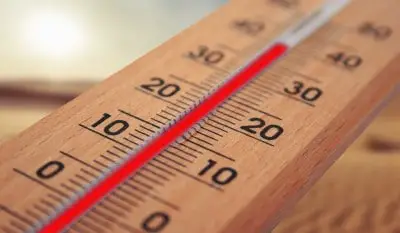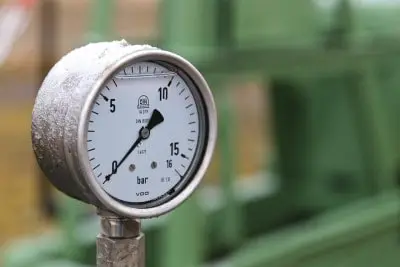Density is an important concept in physics and chemistry. It helps us to compare two substances to see which gas will rise higher, or which solids will sink or float in a liquid.
So, what affects density? The factors that directly affect density are mass and volume. State, temperature, and pressure indirectly affect density, since they can affect the volume of a given mass. Altitude can affect pressure and temperature, and thus density. A mixture of two substances will have a different density than either of the pure substances.
Of course, there are some key equations that will help us to reason through these relationships. For example, Density = Mass / Volume and PV = nRT can help us to sort through some of these factors that affect density.
In this article, we’ll talk about what affects density. We’ll also look at what happens to density when each of these factors increases or decreases.
Let’s get started.
What Affects Density?
The factors that affect density are:
- Mass (direct effect, since it appears in the equation for density)
- Volume (direct effect, since it appears in the equation for density)
- State (indirect effect, since a change of state changes volume of a given mass)
- Temperature (indirect effect, since a change in temperature can cause state or volume to change)
- Pressure (indirect effect, since a change in pressure can cause state or volume to change)
- Altitude (indirect effect, since a change in altitude can cause temperature or pressure changes)
How Do Mass & Volume Affect Density?
Let’s start with the basics to see how each of these factors can affect density. First, we have the equation for density, which is given by:
- Density = Mass / Volume
Basically, density tells us how much mass is in a given space. The more mass there is in a given space, the higher the density.

Similarly, if a given mass is condensed into a smaller space (for example, by high pressure), the density is higher.
As you can see from the density equation, mass and volume have a direct effect on density:
- An increase in mass with the same volume increases density, while a decrease in mass with the same volume decreases density (since mass is in the numerator).
- An increase in volume with the same mass decreases density, while a decrease in volume with the same mass increases density (since volume is in the denominator).
A higher density means that the particles (atoms or molecules) in a substance are more tightly packed together. This is why there is more mass in a given volume: because there are more particles within that space.
If we increase the mass by some percentage X and increase the volume by some percentage Y, then we can find the new density as a percentage of the old density by the equation
- (new density) = ((1 + X) / (1 + Y))*(old density)
Example: Finding The New Density Of A Substance
At first, a substance has a mass of 500 grams and a volume of 100 cubic centimeters. This means that its density is:
- Density = Mass / Volume
- Density = 500 grams / 100 cubic centimeters
- Density = 5 grams per cubic centimeter
After it is condensed, the substance has a mass of 500 grams and a volume of 80 cubic centimeters. This means that the new density is:
- Density = Mass / Volume
- Density = 500 grams / 80 cubic centimeters
- Density = 6.25 grams per cubic centimeter
We can also figure out the new density by using the percent increases for mass and volume. The mass remained the same, but the volume decreased by 20% (from 100 cubic centimeters to 80 cubic centimeters).
This gives us percentages of X = 0 for mass and Y = -0.2 (-20%) for volume. The equation above gives us a factor of:
- (new density) = ((1 + X) / (1 + Y))*(old density)
- (new density) = ((1 + 0) / (1 + -0.2))*(5)
- (new density) = (1 / 0.8)*(5)
- (new density) = (5/4)*(5)
- (new density) = (25/4)
- (new density) = 6.25 grams per cubic centimeter
This is the exact value we found by direct calculation.
How Does State Affect Density?
The state of a substance affects density indirectly by changing the volume of a given mass. Generally:
- A solid has the highest density of the states, since the particles are tightly packed (a given mass fits into a smaller volume or space).
- A liquid has a density between a solid and a gas.
- A gas has the lowest density of the states, since the particles are loosely packed (more spread out). That is, a given mass takes up a larger volume or space.
This means that a substance in its solid state will sink in its liquid state, since the solid state is denser than the liquid state. Likewise, the substance in its gas state will rise above its liquid state, since the gas is less dense than the liquid.
An exception to this rule is one of the most common substances on Earth: water. When water freezes from liquid to solid, the molecules are arranged in a lattice pattern.
The water molecules in this ice lattice pattern are spread farther apart than the molecules in liquid water. As a result, ice (solid water) has a lower density than liquid water.
So, water is a substance where the solid form (ice) floats in the liquid form.

How Does Temperature Affect Density?
The temperature of a substance affects density indirectly by changing the volume of a given mass or the state of the substance:
- A higher temperature causes a state change. Solids melt into liquid form, or at higher temperatures, liquid vaporizes into gas form. As we learned earlier, the solid state is generally the densest, while gas is the least dense state. So, a higher temperature generally means a lower density (due to a higher volume for the same mass of substance).
- A lower temperature also causes a state change. Gases condensate into liquid form, or at lower temperatures, liquids freeze into solid form. So, a lower temperature generally means a higher density (due to a lower volume for the same mass of substance).
Note that the freezing and melting points (temperatures) of a substance are the same (just going in opposite directions). Likewise, the vaporization and condensation points (temperatures) of a substance are the same (again, just going in opposite directions).
Remember that a change in temperature can also cause a change in pressure. For example, the ideal gas law tells us:
- PV = nRT
where:
- P = pressure
- V = volume of substance
- N = amount of substance
- R = ideal gas constant
- T = temperature
So, if temperature of an ideal gas increases while the amount of substance and its volume remain the same, then pressure must increase. Likewise, if temperature of an ideal gas decreases while the amount of substance and its volume remain the same, then pressure must decrease.

How Does Pressure Affect Density?
The pressure of a substance affects density indirectly by changing the volume of a given mass or the state of the substance (for example, in an ideal gas – see the discussion on pV = nRT above).
- A higher pressure causes a state change. Gases are condensed into a smaller volume, which can convert them to liquid form. Likewise, liquids are condensed into a smaller volume, which can convert them to solid form. So, a higher pressure generally means a higher density (due to a lower volume for the same mass of substance).
- A lower pressure also causes a state change. Solids are less condensed and expand into a larger volume, which can convert them to liquid form. Likewise, liquids are less condensed and expand into a larger volume, which can convert them to gas form. So, a lower pressure generally means a lower density (due to a higher volume for the same mass of substance).
As mentioned earlier, an ideal gas follows the equation PV = nRT.
If the pressure increases and the temperature remains the same, then the volume must decrease (the mass is condensed into a smaller space).
If the pressure decreases and the temperature remains the same, then the volume must increase (the mass expands into a larger space).

How Does Altitude Affect Density?
The altitude of a substance affects density indirectly by changing the temperature or pressure of a substance. For example, on Earth, the temperature is lower (colder) and the pressure is lower as altitude increases.
This decrease in pressure is due to less air at higher altitudes. Generally:
- A higher altitude means lower pressure and lower temperature. These factors are at odds, since lower pressure means lower density, but higher temperature means higher density.
- A lower altitude means higher pressure and higher temperature. These factors are at odds, since higher pressure means higher density, but higher temperature means lower density.
The cold at higher altitudes generally means that water is in solid form (ice). In fact, most rain begins as ice and melts as it falls from the sky (this is why rain sometimes feels so cold, even on warm days).

What Affects Density Of Air?
Temperature, pressure, and humidity all affect the density of air:
- At higher temperatures, gases are denser. Warmer air can hold more moisture, so the humidity is higher, which makes it denser.
- At lower temperatures, gases are less dense. Cooler air cannot hold as much moisture, so the humidity is lower, which makes air less dense.

What Affects Density Of Water?
Temperature, pressure, and salinity all affect the density of water:
- When salt is dissolved in water, the same volume holds more mass (due to the mass of the salt). So, higher salinity means higher density.
- At higher temperatures, water becomes less dense. Warmer water can also dissolve more salt, which can also allow for higher density than cooler water.
- At lower temperatures, water becomes denser. The exception is when it freezes, at which point the lattice structure in ice crystals causes the density to decrease. Also, cooler water cannot dissolve as much salt.
You can learn more about how temperature affects water density from the United States Geological Survey website and how salinity affects water density from the University of Hawaii website.

Conclusion
Now you know about the factors that affect density and the relationship between them. You also know the key equation for density and how to use it to reason about changes in mass or volume and how they affect density.
There are lots of other uses for volume besides density – you can learn more in my article here.
I hope you found this article helpful. If so, please share it with someone who can use the information.
Don’t forget to subscribe to my YouTube channel & get updates on new math videos!
~Jonathon

